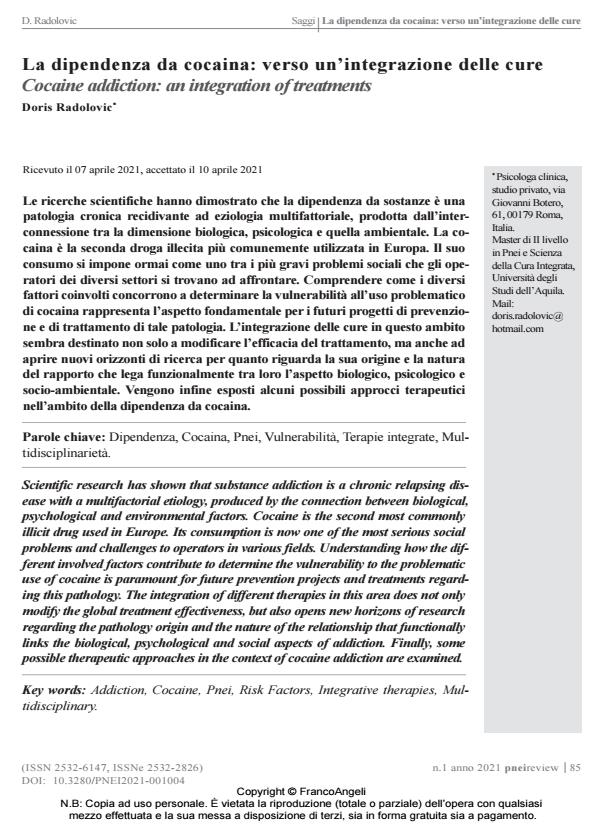La dipendenza da cocaina: verso un’integrazione delle cure
Titolo Rivista PNEI REVIEW
Autori/Curatori Doris Radolovic
Anno di pubblicazione 2021 Fascicolo 2021/1
Lingua Italiano Numero pagine 13 P. 85-97 Dimensione file 1083 KB
DOI 10.3280/PNEI2021-001004
Il DOI è il codice a barre della proprietà intellettuale: per saperne di più
clicca qui
Qui sotto puoi vedere in anteprima la prima pagina di questo articolo.
Se questo articolo ti interessa, lo puoi acquistare (e scaricare in formato pdf) seguendo le facili indicazioni per acquistare il download credit. Acquista Download Credits per scaricare questo Articolo in formato PDF

FrancoAngeli è membro della Publishers International Linking Association, Inc (PILA)associazione indipendente e non profit per facilitare (attraverso i servizi tecnologici implementati da CrossRef.org) l’accesso degli studiosi ai contenuti digitali nelle pubblicazioni professionali e scientifiche
Le ricerche scientifiche hanno dimostrato che la dipendenza da sostanze è una patologia cronica recidivante ad eziologia multifattoriale, prodotta dall’interconnessione tra la dimensione biologica, psicologica e quella ambientale. La cocaina è la seconda droga illecita più comunemente utilizzata in Europa. Il suo consumo si impone ormai come uno tra i più gravi problemi sociali che gli operatori dei diversi settori si trovano ad affrontare. Comprendere come i diversi fattori coinvolti concorrono a determinare la vulnerabilità all’uso problematico di cocaina rappresenta l’aspetto fondamentale per i futuri progetti di prevenzione e di trattamento di tale patologia. L’integrazione delle cure in questo ambito sembra destinato non solo a modificare l’efficacia del trattamento, ma anche ad aprire nuovi orizzonti di ricerca per quanto riguarda la sua origine e la natura del rapporto che lega funzionalmente tra loro l’aspetto biologico, psicologico e socio-ambientale. Vengono infine esposti alcuni possibili approcci terapeutici nell’ambito della dipendenza da cocaina.
Parole chiave:Dipendenza, Cocaina, Pnei, Vulnerabilità, Terapie integrate, Multidisciplinarietà.
Doris Radolovic, La dipendenza da cocaina: verso un’integrazione delle cure in "PNEI REVIEW" 1/2021, pp 85-97, DOI: 10.3280/PNEI2021-001004